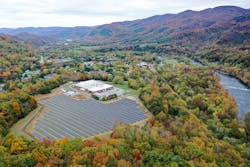Did Duke Energy Just Change the Game for Community Microgrids?
Duke Energy received a lot of attention last week for powering an entire town — Hot Springs, North Carolina — with a microgrid. But the project’s real significance may lie in demonstrating a technology breakthrough that could open a new door to green energy for other communities.
First, some background. A remote mountain town of about 500-600 people, Hot Springs, gets power from the electric grid via a 10-mile, 22.86 kV feeder prone to extended outages.
Duke Energy — the town’s utility — considered building a second feeder line to fix the problem but determined that a microgrid made more sense because, unlike a new line, the microgrid would not disrupt miles of scenic and environmentally sensitive terrain. The North Carolina Utilities Commission agreed and approved the microgrid in 2019.
Hot Springs Microgrid at a Glance
2 MW alternating current solar
4.4 MW lithium-based battery storage
GEMS Digital Energy Platform by Wärtsilä
Acts as backup to the 10-mile distribution feeder line
Provides reliability services to the electric grid, such as frequency and voltage regulation and ramping support and capacity during system peaks.
What Duke was trying to do technologically — the breakthrough — had worked in lab settings but never before in a commercial microgrid, as far as Duke could discern. The complexity of the Hot Springs project, combined with Covid-related supply chain disruptions, led to a slow, four-year build-out of the microgrid.
“We had to be very careful, very calculating because we wanted this to work the first time, and it has. And that’s what we’re most proud of,” said Jason Handley, general manager of Duke’s Distributed Energy Group.
The breakthrough
What was it that Duke Energy achieved? Creation of an inverter-based community microgrid that is capable of black start. In other words, running only on solar and batteries, the community microgrid can restart following a power outage without help from a fossil fuel generator or the electric grid.
As Handley sees it, this approach makes sense for the growing number of communities like Hot Springs that want reliable electricity but also want to minimize their carbon footprint. The utility saw Hot Springs as a proving ground and now plans to build inverter-based community microgrids elsewhere in its service territory, which includes North Carolina, South Carolina, Florida, Indiana, Ohio and Kentucky.
“There are going to be other opportunities for us to do this in some of our coastal territories, some of our other mountainous territories and even potentially in downtown areas where they don't want the noise. To be quite honest, generators make noise,” Handley said in an interview with Microgrid Knowledge.
What sets Hot Springs apart
A microgrid in the Western Australia town of Onslow achieved a similar accomplishment — powering the town on all renewable energy. Still, according to Handley, it did not do so from a black start position, which sets the Hot Springs microgrid apart.
“We literally opened the switch at the substation and killed the line. Everything went dead. And then we brought everything back up,” Handley said. “The battery came back in grid forming mode, setting the voltage, setting the frequency. And, then the solar inverter came back in grid following [mode].”
Duke phased in the process of activating the microgrid, using sectionalizing reclosers. “Blackstart is unique. Inverters have tight current limiting behavior. They do not react well to cold load pickup and magnetic inrush. So they have limitations,” he said.
To resolve the problem, Duke activated the energy through multiple reclosers, just as it would during a power outage on the distribution system. “So we would close one switch, absorb that inrush, and allow the fluctuation, wait another minute, close another switch until we pick up the entire town,” he said.
Safety was a big concern and also the reason the project was slow to bring to fruition.
“The project actually had to go through a couple of different iterations from the standpoint of ensuring that we had the right protection and control settings for an inverter only based microgrid because this is the first one that we've really done,” he said.
More inverter-based microgrids coming
Following the success of the Hot Springs microgrid, Duke plans to bring inverter-based microgrids to projects in Indiana and Florida.
In Indiana, the technology will be applied at the Indiana National Guard Camp Atterbury training operation in Johnson County and a substation in Nabb.
In Florida, Duke Energy plans to install the inverter-based microgrids at sites in Jennings, Micanopy and Trenton, as well as at a middle school campus in St. Petersburg that will serve as an emergency shelter.
The utility learned some critical lessons in building the Hot Springs microgrid, but they weren’t all technological, according to Handley. The project also demonstrated how meaningful building relationships and spending time with the community is to a project’s success.
“I cannot thank the mayor of Hot Springs, the sheriff, the town council enough. They have been great to work with. They've been patient with us over the years,” Handley said. “I think that we have a really good relationship, and I hope to use this as a stepping stone for our other communities as we move forward.”
Read more about community microgrids.
About the Author
Elisa Wood
Editor-in-Chief
Elisa Wood is the editor and founder of EnergyChangemakers.com. She is co-founder and former editor of Microgrid Knowledge.
